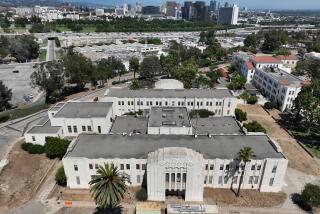Opponents weigh recount on BART tax
Opponents of a ballot measure to expand the Bay Area’s subway system into the Silicon Valley are mulling a recount now that the initiative has squeaked to victory three weeks after election day.
A two-thirds majority of Santa Clara County voters -- 66.67% -- was needed to pass local Measure B, which would raise the sales tax 0.125 of a cent to pay for running and maintaining Bay Area Rapid Transit trains along 16.1 miles of track proposed for the region.
On Friday, the Santa Clara County registrar of voters said that the measure was 0.11 percentage points ahead of the two-thirds needed and that there were so few uncounted ballots left that victory was all but assured.
Although election results will not be certified until next Tuesday, supporters of the $6.1-billion BART expansion through San Jose popped the corks on bottles of California sparkling wine Friday and celebrated a transit fix that they view as being critical to the congested region’s economy and quality of life.
“The passage of Measure B -- the BART initiative -- during the worst economic time in our lifetime underscores that Silicon Valley residents have the vision to bet on and build for our future,” said Carl Guardino, president and chief executive of the Silicon Valley Leadership Group, as well as the campaign’s leader.
Not so fast, opponents said Tuesday, when the remaining votes were finally tallied and the registrar put the measure ahead with a “very close” 66.78% of the vote.
“We are assessing our options with respect to a recount,” said Margaret Okuzumi, spokeswoman for the No on Measure B effort.
A recount can be requested up to five days after the vote is certified.
Okuzumi’s group has yet to request one, she said, and the registrar’s office must still give the organization a cost estimate for the process.
Okuzumi’s group opposed the tax to extend BART to the San Jose area in part because of fears that the project would suck critical transportation dollars away from other services, such as existing bus and train routes.
But they are considering a recount because “it seems strange that the provisionals would be putting [the measure] over the top,” Okuzumi said, referring to the 30,000 ballots that were counted last.
Provisional ballots must be authenticated by election workers because they are cast in unusual circumstances. A voter may have asked for a mail-in ballot and then shown up at a polling place without it. Or a voter may have gone to the wrong precinct.
For days, the outcome of Measure B teetered in the balance, as first the 134,000 mail-in ballots were counted and then the provisional ballots were investigated and tallied.
Measure B headlines on the San Jose Mercury News website ranged from “falling short of needed two-thirds majority” late on election night, to “too close to call” on Nov. 5.
Two days later, the paper mourned that the measure was “headed to defeat” before crowing last Friday: “BART backers pop open champagne, celebrate vision for San Jose’s Grand Central Station.”
The possibility of a recount aside, Measure B’s passage brings the San Francisco Bay Area one big step closer to the original 1950s concept of unbroken rail transportation ringing the bay.
It has been a long time coming.
In 1957, the state Legislature approved the creation of a five-county BART district, an early concrete step toward building the original 71.5-mile system. That same year, Santa Clara County supervisors decided to build more roads instead of joining BART. And in the 1960s, San Mateo and Marin counties’ boards of supervisors voted to opt out.
“Joe Ritter, the publisher of the Mercury News, felt very strongly that they not become part of BART,” Guardino said. Fast forward to the early 1990s. The Silicon Valley had matured into the region’s economic engine. BART officials traveled to Santa Clara County to talk about extending the route to San Jose.
But the meeting was acrimonious -- insults, not results -- and talks broke down.
The outlook brightened in 2000, when voters resoundingly approved Measure A extending an expiring half-cent sales tax to pay for transportation projects, including the construction of a BART line into Santa Clara County. That year, then-Gov. Gray Davis earmarked $760 million in state funds for the project.
Then the dot-com bust devastated the region’s economy. Seventeen of every 100 jobs were lost, Guardino said, and it “changed the entire sales tax future.”
By 2004, the federal government gave the project a “not recommended” rating because there was no money to operate the system even if it was built. Local planners began pondering a shortened route and other options.
Measure B on the Nov. 4 ballot was designed to solve the problem of where those operating funds would come from. If the victory stands, there’s still one hurdle standing between San Jose residents and a BART ride north.
The federal government has pledged $750 million to help build the project, but will not hand over the money until the Santa Clara Valley Transportation Authority proves that there’s money to operate and maintain the system. Measure B won’t start gathering the new sales tax until federal funds are in hand.
“We’re in a Catch-22,” said Michael Burns, general manager of the transportation authority, who nonetheless believes the project is in “a pretty strong position.”
“It’s a good project,” Burns said. “It’s a project for the future, an investment for the transportation infrastructure for the region. People 20 years from now will be saying why did it take so long to do.”
--
More to Read
Sign up for Essential California
The most important California stories and recommendations in your inbox every morning.
You may occasionally receive promotional content from the Los Angeles Times.










